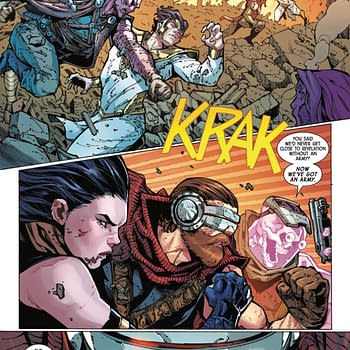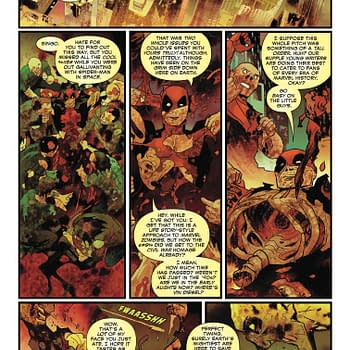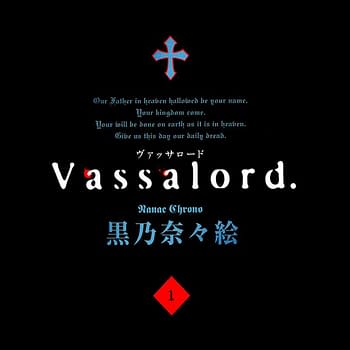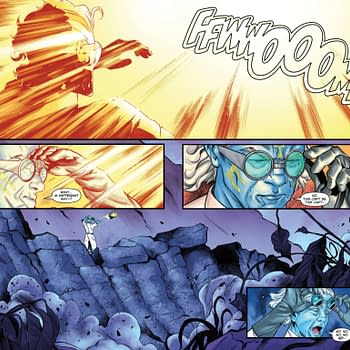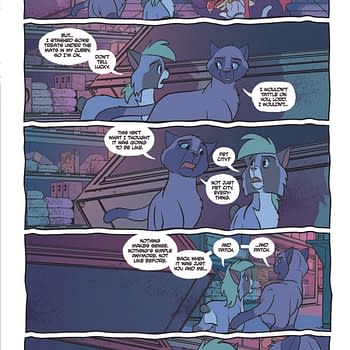Posted in: Comics | Tagged: Alien Vs Predator, axis, batgirl, Comics, dc comics, Earth 2: World's End, entertainment, Hawkeye Vs. Deadpool, Jack Hammer, Marvel Comics, October Faction
Thor's Comic Review Column – Earth 2: World's End, The October Faction, Avengers/X-Men Axis, Alien Vs. Predator, Batgirl, Jack Hammer, Hawkeye Vs. Deadpool
This Week's Reviews:
Earth 2: World's End #1
The October Faction #1
Avengers / X-Men Axis #1
Alien Vs. Predator: Fire and Stone #1
Batgirl #35
Jack Hammer #1
Hawkeye Vs. Deadpool #1
Earth 2: World's End #1 (DC Comics, $2.99)
By Graig Kent

Earth 2 could stand on its own, and where the main DCU was under extensive scrutiny to live up to what came before with every change to beloved characters put under a microscope, in Earth 2 Robinson (and current writer, Tom Taylor) could kill Superman, Batman and Wonder Woman, make Green Lantern gay, turn Lois into Red Tornado and basically do whatever they want with basically any character in that universe. It was a true representation of what the New 52 reboot should have been, a fresh start with few ties to its past, forging ahead with its own story.
The cynical perception could be that Earth 2 is just DC's version of Marvels Ultimates, a second, darker ongoing thread of the concepts the company makes its bank from. Yet, what has distinguished Earth 2 from that Ultimate Universe is the ties it has back to its proper core universe, ties it has had from the start in Paul Levitz's World's Finest (and more recently with Greg Pak's Batman/Superman). In the past few months, those ties have been growing even stronger, with a major establishing point of the Futures End weekly being that Earth 2 succumbed to evil invading forces and millions of refugees made their way to Earth 1.
Most of Robinson's run on Earth 2 involved the world desperately finding replacement for its lost Trinity, as the battle that cost them their lives did not quell invading hordes from Apokolips. As Futures End has foretold (in as much as it's a "true" 5-years-later), eventually Darkseid and his minions will overwhelm Earth 2's heroes and find their way alongside the refugees to Earth 1, igniting the "Earth War".
There's predestination at play here with the new weekly series Earth 2: World's End (note the apostrophe here that's missing from "Futures End"), as it seems to be tasked with fleshing out the trajectory to "Earth War" in raw detail, assuming then that Tom Taylor's Earth 2 series is then liberated from such a task. The end destination of this weekly may be known (assuming that Futures End can be trusted, which I'm not certain it can), but the story is about the journey getting there.
Tasked with this job is writer Daniel H. Wilson, joined with Marguerite Bennett and Mike Johnson. The first issue of the book, much like the first 5 paragraphs of this review, is all just set-up, catching the new reader up (and refreshing the old ones) with what has gone on so far. It takes 21 pages, the size of an average modern comic book single, to recap the past 25 or so issues of Earth 2, plus some relevant plot points from World's Finest and Mister Terrific. It's a dizzying info-dump for the uninitiated, but Wilson tackles it with surprising fluidity and an epic sweep that gives the new reader just enough to get started without belaboring any points for the old reader.
The story of World's End kicks off on page 22, revealing a war-ravaged and war-weary planet eager to rebuild and move on. Some know the threat isn't over yet, but the powers-that-be don't seem to share that concern. Of course, by the final pages, they will be more than aware, but therein lies the crux of the series. Key focal points include Dick and Barbara Grayson as ground-level POV characters, Power Girl and Huntress' return to Earth 2, Doctor Fate's seeming dementia, and Baron Bedlam's kidnapping of two Misters Terrific and one Mister Miracle.
Again it's all set-up, and if it suffers anything it's the same as Futures End: too much going on to invest enough in any one thread in such short doses. Like Futures End, though, I can tell already that there's a level of scale to what's happening that will be far more satisfying with concentrated reading, and form a grander big picture once complete.
There's no "must read" sell to World's End, at least not yet, but the publisher's hints that this is the second part of a trilogy (along with Futures End) may make it something definitely worth coming back to if the week-to-week investment doesn't have any allure. At $2.99 and 38 pages, it's at least a bargain worth checking out to see what the whole "Earth 2 thing" is about.
Graig Kent keeps promising to finish the final edit on that novel, play test that board game, start drawing that web comic, find an artist for that children's book, and maybe write that teleplay, but first he's got to read that pile of comics and watch that backlog of movies…and all that cheese wont eat itself. He's been reviewing things for over 15 years. He's rarely on twitter @thee_geekent, he sometimes writes about movies at [wedisagree.blogspot.com], and his dog has a blog [tacomblur.tumblr.com]
The October Faction #1 (IDW Publishing)
By Bart Bishop
It's that time of year again. As a big fan of fall, Halloween and the horror genre in general, it's natural that The October Faction will appeal to me. First of all, it's written by Steve Niles, best known for his 30 Days of Night. Secondly, the art is by Damien Worm, whom I am not familiar with but has a painterly style very similar to Ben Templesmith, the artist on 30 Days of Night. The end result is an intriguing riff on The Addams Family that's familiar to fans of the macabre. It's certainly not the most original, focusing on a family of ghoulish oddballs, but it balances a whimsical tone amidst the dripping dread, with likable characters that actually enjoy their lives. The October Faction, seemingly taking its name from the spooky month without actually acknowledging the title in the book, could have simply been gothic doom and gloom but instead promises fun monster mash antics.
The premise is around Fredrick, a college professor of…folk lore, I suppose? He's a former monster hunter, having gained his knowledge of the occult from experience, and after teaching a class he's approached by his former partner Lucas. It's been forty years since they've worked together, and Lucas has come to warn Fredrick that the latter's wife, Deloris, is having an affair. Of course, it's something much more than that. Meanwhile, Fredrick and Deloris have two children, Geoff and Vivian, who are mages in training. Geoff is a year out of high school and Vivian just graduated, and the two obviously didn't make friends at their respective institutions. Around town they're ostracized by the norms but they aren't bothered, seeing as they're privy to both past and future truths, a kind of magical cosmic awareness. Of course back at their Victorian mansion straight out of Tales From The Crypt they are dabbling in the black arts, hoping to get their father's attention.
Niles has a handle on characters even if they are led through clichéd situations. Geoff is first on the scene and is established with economy when he encounters a former high school bully. One would expect the situation to go the way of Carrie, with the misbegotten outsider dishing out a horrific payback, but Geoff takes control of the situation immediately, frightening the bully with a dark secret. It's unfortunate that sister Vivian is introduced with the exact same kind of encounter, with a group of mean girls heckling her. Father Fredrick is introduced, as well, with that old chestnut, the classroom scene in which the professor has a five-minute monologue that appears to be the entirety of class time. Still, the dynamics and relationships are all there, and the rapport between Fredrick and Lucas rings true in terms of their history. I also love the everything-but-the-kitchen-sink worldbuilding, with the black-and-white flashbacks to a fateful battle hinting at a greater mystery, possibly tying into whatever mother Deloris is up to with that key and storage unit.
Worm certainly maintains continuity with Niles's oeuvre, but the incessant dream-like aesthetic serves no diegetic purpose. It would be highly appropriate for the supernatural elements to look like Scary Stories to Tell in the Dark or Ashley Wood's Spawn work, but why the scenes of everyday life? It robs the big reveal of the spirit locked in Geoff's closet of any shock when the cast appears to be stuck in Silent Hill for the duration. When it is appropriate, however, it's very appropriate. The aforementioned ghost in the closet, flashbacks to werewolf and vampire encounters and a splash page of the family estate, an image of particular beauty with its sense of depth and askew blocking, are arresting in their composition. Again, however, the murky, oppressive sense of the ephemeral makes scenes like Deloris unlocking…something from a casket lack any impact. What exactly am I looking at?
A promising start and a great read for this time of year, even if Niles and Worm have become too comfortable in their wheelhouses.
Editor and teacher by day, comic book enthusiast by night, Bart has a background in journalism and is not afraid to use it. His first loves were movies and comic books, and although he grew up a Marvel Zombie he's been known to read another company or two. Married with a baby girl on the way, he sure hopes this whole writing thing makes him independently wealthy someday. Bart can be reached at bishop@mcwoodpub.com.
Avengers / X-Men Axis #1 (Marvel, $4.99)
By Jeb D.
Original Sin represented the first serious stumble of Jason Aaron's Marvel tenure, but not every writer, even good ones, is attuned to the niceties of the corporate crossover cash-grab (since his relaunched Thor is still going strong, we'll just give him a pass on the whole mess). Now, Rick Remender, another of the indie guys that followed Bendis and Brubaker to the House of Mouse Ideas, takes his shot with the first issue of the awkwardly-titled Avengers / X-Men Book One: The Red Supremacy Axis.
Remender has something of an advantage going in, as this monster mash hasn't popped out of thin air, but has been allowed to grow more or less organically from his run on Uncanny Avengers… which is another way of saying that, two years on, we're still dealing with the Red Skull and his theft of Charles Xavier's powers. Of course, he's no longer merely the Red Skull, he's now the Red Onslaught (I don't keep up on the X-Men much, so I don't know how many hues Onslaught has come in up to this point). He's big and monstery, with pointy wings, Spawn-like claws, and an 80's-vintage metallic six-pack; it's a look guaranteed to terrify anyone who's scared of Rob Liefeld.
While I've been reading Uncanny Avengers, as I say, I'm pretty far behind on the X-verse proper (though I understand that, thanks to Ike Perlemutter, I no longer have to worry about anything new happening there ever again), so I guess I'm glad that this 30-page comic comes with two full pages of recap, plus one of dramatis personae. On t'other hand, I'm not sure that we really need much more than one great John Cassaday panel of the grinning, mind-messing Red Skull to be up to speed. Our heroes begin by assembling to take down Plantman, who is rather disappointingly played pretty straight (for Remender, anyway), but then, he's only the backdrop: the opening section is mostly just to give us a hint of the effect that the perversion of Xavier's mind powers will have; which, at this point, mostly seems to be making all our heroes bad-tempered and snarky.
Anyone who cares to cast their memory back to the early issues of Uncanny Avengers will have some idea of the setup here: a strife-laden populace deluged in Madbomb-like waves of mental hate, with our various heroes hampered by the fallout of Original Sin; or, as Magneto helpfully sums it up for us: "My God… the world's gone mad." I get that there's some kind of inversion coming (the backmatter not only previews covers of upcoming issues, but gives tidy little synopses of the progression of the story, to save you time), but so far, it's mostly just the usual superhero action and angst.
Thanks to Adam Kubert, it's pretty good action and angst (well, action anyway): plenty of variety in the layouts and paneling, lots of cinematic perspective, rain, lightning, and rage-faces. Laura Martin and Matt Milla provide outstanding coloring work, keeping the story's head-snapping shifting of locales and perspectives clear.
For anyone curious as to how this fits into the new Marvel status quo: Sam Wilson is not only Captain America, but he's already being resented for handing out orders; Thor's got his axe in place of Mjolnir; Tony Stark is acting like a dick, but it's hard to tell if he's being a Superior dick yet or not; and Black Widow's sole appearance gets her dissed for watching reality TV. So…um… I'm not really sure. It's possible that I'll learn more if I read the upcoming issues of the eight (and counting) different series that this thing will spill over into; I wonder if it all might lead to a Secret War?
Jeb D. is a boring old married guy whose comics background includes attending the very first San Diego Comic-Con, being lectured on Doc Savage by Jim Steranko, and fetching an ashtray for Jack Kirby. After a quarter-century in the music biz, he pursues more sedate activities these days, and will certainly have a blog or Facebook account or some such thing one day.
Alien vs. Predator: Fire and Stone #1 ($3.50, Dark Horse)
By D.S. Randlett (@dsrandlett)
A lot of the pitches I hear for Dark Horse's Fire and Stone event, a crossover between the Prometheus, Aliens, and Predator franchises play up the fact that the writers are using something like television writing as a template for writing the series, where there is a showrunner and a group of writers bouncing ideas around to see what works. When planning an event like this, with writers spearheading a series of smaller stories weaving into a larger one, this approach makes sense, and the high-caliber talent here makes this series hard to resist. This is, of course, despite the fact that two of these three franchises simply don't feel vital anymore while the third is composed of an ambitious failure and a yet to materialize sequel. Nevertheless, Fire and Stone has its finger on the pulse of a particular pop culture moment, from how it is crafted to what it is.
We are living in the age of the crossover, a cultural moment where stories aren't on offer as much as entire worlds. The movies are enough of a testament to this. While Marvel and DC's upcoming films and TV projects promise viewers an inescapable trip through their respective universes, every day brings more announcements of other film projects hoping to throw their hats into the same arena with their own "shared movie universes," such as the recently announced Robin Hood (we will get one movie out of this, guaranteed). So many of these projects are years away from bearing fruit that any pop culture consumer must feel like the Romans whenever they found out the Carthaginians or the Teutons were on their way: it's just a matter of time before your world ends. You will have to be content with the world of Robin Hood.
Of course, this is the sort of thing that comic books have been doing for years, and it's something of an inevitability with serialized storytelling and increased sales whenever certain characters team up. Or fight. Hence the original Aliens vs. Predator series, which in weird way prophesied the current cultural climate by positing that these two different movie worlds could coexist and compliment each other. The original series still holds up, and is just a solid sci-fi romp, seamlessly melding the action horror of the James Cameron-directed sequel and the sweaty brawn of John McTiernan's vehicle for superstar Shane Black while still charting its own path. The movies, of course, wouldn't get it.
Under the stewardship of Christopher Sebela and Ariel Olivetti, one of Dark Horse's flagships seeks to make something of a comeback. I think that it's very telling that this series is titled Alien vs. Predator. Without the "s." Sebela's script starts on familiar enough territory, with a Predator hunting party rounding up some prey on a weird planet. That's where the similarities pretty much end, as the series then picks up with the crew seen in the first issue of Prometheus: Fire and Stone, naturally a few members short, and one horribly changed. The rest of the story unfolds in the confines of an isolated spaceship, rather than the open spaces of a terraforming colony.
Already one can see how this crossover is getting the promise of the Prometheus film incredibly right. Prometheus was essentially about divine terror, and as a film it unfortunately could not own up to its premise or the questions that it was asking. It at once challenged old tropes about belief, only to fall back on those same tropes in a way that did not feel of a piece with the thematic milieu of the film. Here there are a group of characters that have been changed by a similar experience and transformed by that same divine terror. And it's complimented very well by the Aliens, who have always worked best as symbols of entropy and humanity's eventual demise. The Predators are still something of an x-factor here, but on a pure surface and plot level, it's enticing to see these action characters thrown into a world of claustrophobia and existential terror.
And surprise, Olivetti's art is pretty dang great. Most striking is his use of texture here, and his use of space. The ships the characters inhabit feel like huge, damned temples and cramped trenches all at once. And the bio-horror just drips of the page. Movies are really good at goo, while it can seem rather pedestrian in comics. Olivetti makes captures the sliminess inherent in the franchise, which makes the gore hound in me incredibly happy.
I would not recommend reading Alien vs. Predator apart from the other Fire and Stone series, however. The creators on this project are doing something interesting with how they are unveiling this story, with each release and each series jumping around in the timeline of the narrative. This has the effect of altering certain expectations as to the outcome of the other series while adding a degree of intrigue in its own right. Still, when each of the titles in Fire and Stone are this solid, that shouldn't be too hard of a sell. It's the crossover done right.
D.S. Randlett lives in the hills of Virginia and takes credit for the reviews that his emaciated twin brother writes while chained to the old radiator. He plays his guitar while biding his time for unsuspecting tourists and thinking about going to grad school.
Batgirl #35 (DC Comics, $2.99)
By Devon Sanders
I miss Oracle.
I've largely stayed away from New 52's Batgirl for this reason. Barbara Gordon, as Oracle, was the ultimate realization of a character's potential and all it took was The Joker's crippling her and writers John Ostrander and Kim Yale knowing her story shouldn't end there. Ostrander and Yale took Barbara Gordon from someone who was seen as a bit of a Bat-Mary Sue to a character who called her own shots. As Oracle, Barbara Gordon realized her potential, doing this Batgirl never could've done. As Oracle, she became a member of The Justice League. As Oracle, she led her own team, The Birds Of Prey consisting of DC Comics stalwarts Black Canary and The Huntress.
As Oracle, she became someone Batman went to for advice. That was the main thing; she was allowed to go from someone who needed the Bat-Family as validation to someone who not only was wanted but needed within Batman's world. As Oracle, she was allowed to grow and with the dawning of DC's New 52, Barbara's becoming Batgirl again, well, felt a bit like a demotion.
So, I stayed away. From Batgirl. From Birds Of Prey. From Barbara.
With DC's announcement of a soft Batgirl reboot that focused more on the girl than the bat, I found myself intrigued. After reading Batgirl #35, I found myself… well, at least interested.
Barbara finds herself in a sea of changes; The Birds Of Prey have disbanded under less than amicable circumstances, she finds in a new neighborhood with new roommates. And with so many new changes come new challenges. A series of smartphone and laptop thefts leads Batgirl into the shady ass world of Hooq, the New 52's equivalent of Tinder. It's Batgirl versus people looking for love and others' secrets in all the wrong places.
Writers Cameron Stewart and Brenden Fletcher are definitely crafting a tale with younger readers in mind. Characters literally speak in hashtags and colloquialisms and at times, it's a little TMI. Unfortunately, too many of the main characters come off as not entirely self-aware and entirely self absorbed. It's a comic full of first issue problems; overdrawn bank accounts, the risks of online identity and such but here's hoping Barbara moves beyond her living room and her neighborhood as I found the antagonist of this particular issue a bit beneath Batgirl.
Art-wise, the book is in very capable hands of comics newcomer Babs Tarr. In a comic where there's as many as 12 (!) panels per page, Tarr makes them feel uncluttered, easily allowing the eye to flow on to the next panel. For a newcomer, she comes across as a seasoned hand and I look forward to seeing where she takes this book, as well as her career.
Batgirl #35 is a very interesting start. It's a bit rough in places but shows tons of potential and isn't that what new starts are all about?
Devon Sanders, the writer of this piece has a metal G.I. Joe lunchbox signed by G.I. Joe creator Larry Hama. It has nothing to do with the review or anything else but he just wanted you to know about that lunchbox. He can be found on Twitter at @devonsanders.
And he still misses Oracle.
Jack Hammer #1 (Action Lab, $3.99)
By Cat Taylor

Through most of this comic, I felt like I was reading a very by-the-numbers hard-boiled detective novel adapted to comic book format. Even the name of the book is only a first name away from "Mike Hammer." For me, that was a bit of a problem since I never really got into that genre. So, I had to take that into consideration when writing this review. Regardless of my personal taste, I felt like Brandon Barrows' story would have been a bit easier to get into if I had a clearer picture of exactly what Jack McGriskin was investigating. It's one thing to receive and learn clues as a detective proceeds, but not even knowing the assignment was an extra layer of mystery that I don't think was intended as part of the "whodunit". However, the investigation that seemed central to this story was nothing but window dressing, presumably meant only to establish Jack as a noir-style detective. As it turned out, there was an actual sort of novel twist in this issue involving some characters with mental powers of a telepathic nature. The story ends with a pretty captivating moment and two epilogues that are meant to draw in the reader for the next issue.
Although the added twist and cliffhanger ending give some promise that it could be worthwhile to continue the series, for me it was too little too late. In addition, the artwork by Ionic wasn't particularly captivating. It's not that I have any complaints about the art, because it is all very competently rendered and doesn't negatively distract from the story, but there's nothing unique about it either. It's another example of the modern art-style that I've seen more often than not, especially in independent comics, where characters are rendered as sketchy outlines with distinct colors and details filled in to identify them. It's a common minimalist approach that intentionally keeps the rough edges. While it works well in illustrating a story, none of the artists who use this style stand out in a crowd.
Admittedly, I may be missing out on a great read if I don't continue the series but I feel like all the focus on establishing characters and an environment of a Micky Spillane-like world really requires one to have an affinity for that sort of thing even with the mind-power twist that was introduced into the story. As such, if you are a hard-boiled detective fan who also likes science fiction or superheroes, then give ol' Jack Hammer a look. If that doesn't sound like your thing then you probably won't miss anything by giving this one a pass.
Cat Taylor has been reading comics since the 1970s. Some of his favorite writers are Alan Moore, Neil Gaiman, Peter Bagge, and Kurt Busiek. Prior to writing about comics, Taylor performed in punk rock bands and on the outlaw professional wrestling circuit. During that time he also wrote for music and pro wrestling fanzines. In addition to writing about comics, Taylor tries to be funny by writing fast food fish sandwich reviews for Brophisticate.com. He also doesn't know what that was stuck to the floor behind his refrigerator but confirms that it tasted terrible. You can e-mail him at cizattaylor@hotmail.com.
Hawkeye vs Deadpool #1 (Marvel, $3.99)
By Jeb D.
It took the Big 2 long enough to twig to the fact that their market had an insatiable appetite for #1 issues, but they eventually figured it out, thus our current state of constant reboot and relaunch. But the sales potential inherent in the "0" issue has not, up to this point, been fully exploited. Typically, 0 issues have been standalone place-setters, quick-buck loss leaders, or sometimes afterthoughts released when the "main" series has already concluded. But someone in the marketing department at Marvel has worked out that if you kick off your new series with a 0 issue that is not vestigial, but is in fact the beginning of the story, that allows you the chance for a nice sales bump when the second issue is designated "#1" (I'll be very disappointed if the next installment of this series isn't "Issue # Alpha"). Good job, Kyle.
Because, yeah, this is just the second part of the story that began in the 0 issue last month, with Wade and Clint engaged in Halloween shenanigans, and they're still in pursuit of a purloined list of SHIELD agents, while fending off the lethal attentions of mind-controlled civilians dressed as superheroes. In a way, this might have been an easier crossover to pull off a few years ago, when Deadpool could be paired with pretty much any straight-arrow (sorry) superhero, bouncing one-liners off his spandexed straight man, and it would have worked just as well with Hawkeye as anyone else. But in the wake of the Fraction-Aja Hawkeye, it becomes a trickier proposition: Clint's not exactly a slacker, but he's written with an awareness of that environment, and while he is very much a straight man today, his principal antagonist is not a motormouthed laff machine, but the one-damn-thing-after-another grind of life itself. It helps that writer Gerry Duggan is comfortable enough with Deadpool to find character moments that don't require him to spout jokes in every panel, and the involvement of his family in the holiday fun makes it harder for a man with Clint's own family issues to dismiss him outright. That's not to say that the book isn't funny, but the reluctant Clint-Wade bonding resonates in ways that go beyond the wacky.
Duggan also hands great stuff to his female characters: Typhoid Mary, Black Cat, and Kate Bishop actually get many, if not most, of the best lines (and the final-page silhouette promises even more to come); Kate, in fact, is the only one who actually does any useful detecting.
Unlike last issue, artist Matteo Lolli (with inks by Jacopo Camagni) resists the temptation to incorporate David Aja-style infographics, which is mostly to the good: his own style is big, bold and vibrant, pretty to look at, crystal-clear in the storytelling, and vigorous in the action sequences; it's classic old-school superhero, with some great facial work (Kate's wordless reaction to her first view of the unmasked Deadpool is probably the best moment in the book). With vibrant colors by Cristiane Peter, it's not the look you typically think of for a "humor" comic, but it works just fine for this entertaining, amusingly prickly, buddy-cop caper.















